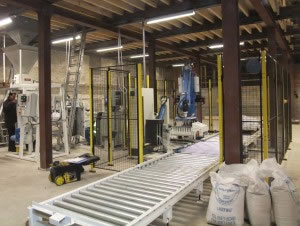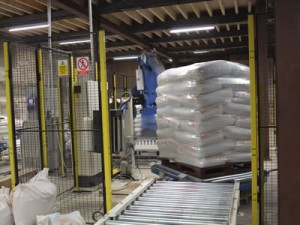CASE FOR BLU-ROBOT STACKS UP AT UK MALTSTER
The secret of success in virtually any business is delivering what customers want, and at Thomas Fawcett & Sons, investing in two pre-owned palletising robots from Pacepacker Services has achieved exactly this, while at the same time doubling throughput and reducing labour costs on two of its packing lines.
The family-run maltster and malt roaster supplies 25kg bags of malt to the brewing and food industries, and orders tend to be for a one-tonne pallet (40 bags). “Our customers were regularly asking for 40 bags on a pallet, which we could do manually – but with difficulty,” says Brian Hickman, general manager of the West Yorkshire factory. “Hand-stacking eight layers of five sacks was not easy, due to the height of the load, and resulted in untidy and unstable pallets.
“Now that we’re using Pacepacker’s Blu-Robots to palletise sacks, our customers get what they want; we can do 40 bags to a pallet without any problems, and the pallets are uniform and neatly stacked.”
Pacepacker’s Blu-Robot palletisers are re-conditioned six-axis robots that originate primarily from the automotive industry. The robots, which are approximately a third of the way through their lifespan, are supplied to packaging users pre-programmed and complete with end-of-arm tooling, controls and a 12-month warranty with service and spares back-up. They are typically half the cost of a new system, enabling the user to achieve a far quicker payback.
“The Blu-Robot is ideal for companies looking to palletise eight to ten bags per minute. Buying a new robot would mean buying an over-specked, faster robot and paying for capabilities that simply aren’t needed,” explains Paul Wilkinson, Pacepacker’s business development manager.
At Thomas Fawcett, the Blu-Robots were part of a project to part-automate two lines for packing pale and crystal malts. Previously, the entire packing process on these lines was carried out manually, requiring seven production personnel. “Staff hand-packed the malt into sacks on a counter-balance weigher; sacks were then hand-tied and palletised and stretch-wrapped by hand,” recalls Brian Hickman.
A visit to an existing Pacepacker customer, I’Anson Bros, convinced Thomas Fawcett that Pacepacker’s bagging and robotic palletising equipment would enable it to cope with growing sales by increasing throughput.
Pacepacker’s willingness to work within the space constraints at the Castleford factory was another factor in its favour.“The site is a historic building and in both packing areas the space for the new lines was restricted by columns. Pacepacker went to great lengths to design a layout that was bespoke to the space available,” says Brian Hickman.
By Christmas 2011, Pacepacker had installed and commissioned the first line, incorporating its Total Bag Control (TBC) system, a stitching unit, a motorised sack kicker and the Blu-Robot.
An operator places a bag on a sack holding device to start the filling and weighing process, in which malt is transferred from a hopper into 25kg bags via a gross weighing system. The TBC system then takes hold of full sacks with a pair of grip arms and motors toward the stitcher. Sealed sacks are laid down using a motorised sack kicker, and transferred to the robotic palletiser on a flat belt conveyor. Empty and full pallets are fed through the system on powered rollers, and full pallets are automatically indexed onto a rotary stretch wrapper. Wrapped pallets are fed out of the guarded area for collection by fork lift trucks.
The second line was up and running by January 2012, within the time frame agreed with Thomas Fawcett.
“Pacepacker have been very professional in terms of meeting deadlines, keeping in regular contact and providing very detailed design work. We felt throughout that they were a company we could trust,” says Brian Hickman.
He reports that since semi-automating the lines, throughput has doubled and that the investment is well on the way to paying for itself, largely through labour savings, as now only two operators are required to man each line.
“We were doing about two bags a minute with the old system; now we’re doing double.”

































